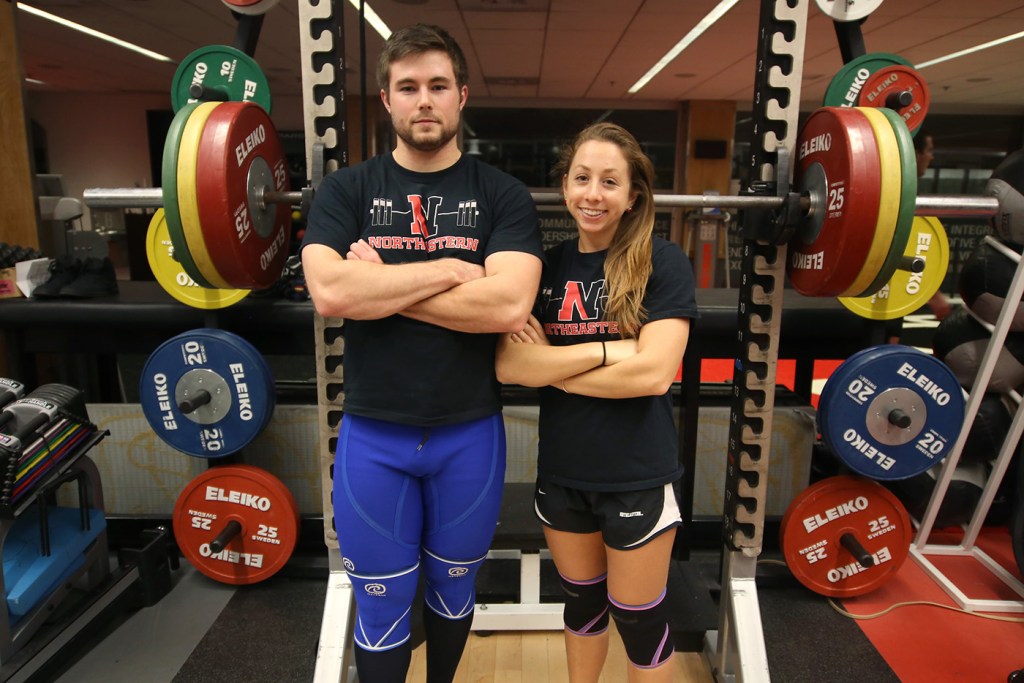The strength factory

Unlike the prototypical weekend warrior, the purposeful powerlifter eschews physical aesthetics in favor of sheer strength. His philosophy is threefold: lift heavy, train hard, get stronger.
“Other weightlifting programs aim to make you feel better or look better,” says Matt Cassista, the president of the men’s powerlifting club at Northeastern University. “The primary goal of powerlifting is to put more weight on the bar every time you hit the gym.”
Indeed, Northeastern’s powerlifting program is something of a strength training factory, producing scores of formidable athletes every year. Cassista, E’15, is a prime example. He finished fifth in the 205-pound weight class at the 32nd Annual National Collegiate Powerlifting Championships in April, squatting, bench-pressing, and deadlifting a combined total of 1,681 pounds. Emily Liebert, the president of the women’s powerlifting club, predicts that she will win the 125-pound weight class at the 33rd annual collegiate championships next spring.
“I’ve trained really hard and I’m so determined,” says Liebert, BHS’15, who has been powerlifting for four years. “I’m motivated to win.” She plans on warming up for the big event by squatting and bench pressing a combined total of 452 pounds at this weekend’s New England Open—an unprecedented amount of weight for a 123-pound American woman.
Liebert’s powerlifting prowess is not surprising. In her salad days, she trained under the practiced eye of Joe Cappellino, E’11, who co-founded the men’s powerlifting club in 2007 and later set the collegiate record for squatting, bench pressing, and deadlifting combined: a total of 2,292 pounds. Over the past few years, she has worked closely with Michael Zawilinski, the powerlifting club’s head coach and the leader of Team USA’s powerlifting program.
“The combination of Joe and Mike has led us to be the team we are today,” Liebert says. “Joe taught us what powerlifting is all about and Mike is an amazing coach, spending endless time trying to translate Russian programs to teach us how to train and get stronger.”

A member of Northeastern’s powerlifting club performs a squat during a Sunday evening practice in the Cabot Center.
The rise of the powerlifting program is well known: The incipient popularity of the men’s club—which grew from two to 20 members in its first two years through the diligent recruiting efforts of Cappellino and co-founder Eli Laipson-Williams, AMD’11—led to the inception of the women’s club in 2009. Today the two clubs comprise 64 members, including 36 men and 28 women.
The women fared better than the men at the collegiate championships in April—the girls placed fourth and the guys finished seventh—but both clubs figure to perform even better next spring. “We have a championship caliber lifter in almost every single weight class,” says Liebert of her club’s physical makeup. “We’re going to win.” Notes Cassista: “We have a pretty strong group of veterans whose previous experiences will be very helpful.”
The powerlifters prepare for competitions at group practices on Tuesday, Thursday, and Sunday evenings in the Cabot Center, where they focus on maximizing their squat, bench, and deadlift. On off days, they perform accessory exercises, like bent rows or triceps pushdowns, and dabble in high intensity interval training or steady state cardio. The routine yields results: “I don’t think people realize how quickly you can progress when you commit to a tried and true program that’s designed to get you strong,” says Cassista, who has been lifting things up and putting them down for three years.
“Powerlifting is a full body workout,” Liebert adds. “It’s easy to see how much stronger the team’s first-year lifters have gotten by simply attending practice and following the program.”





